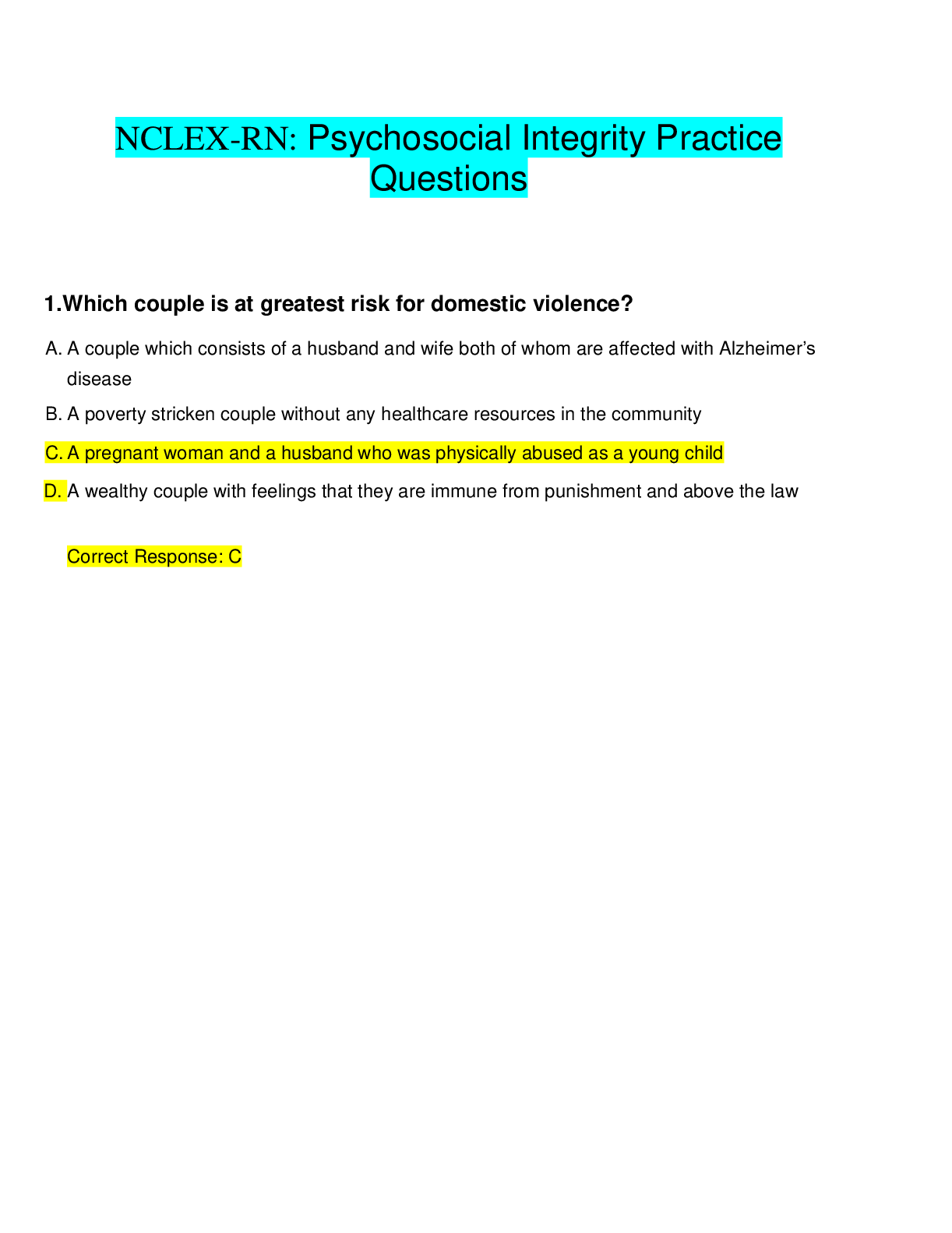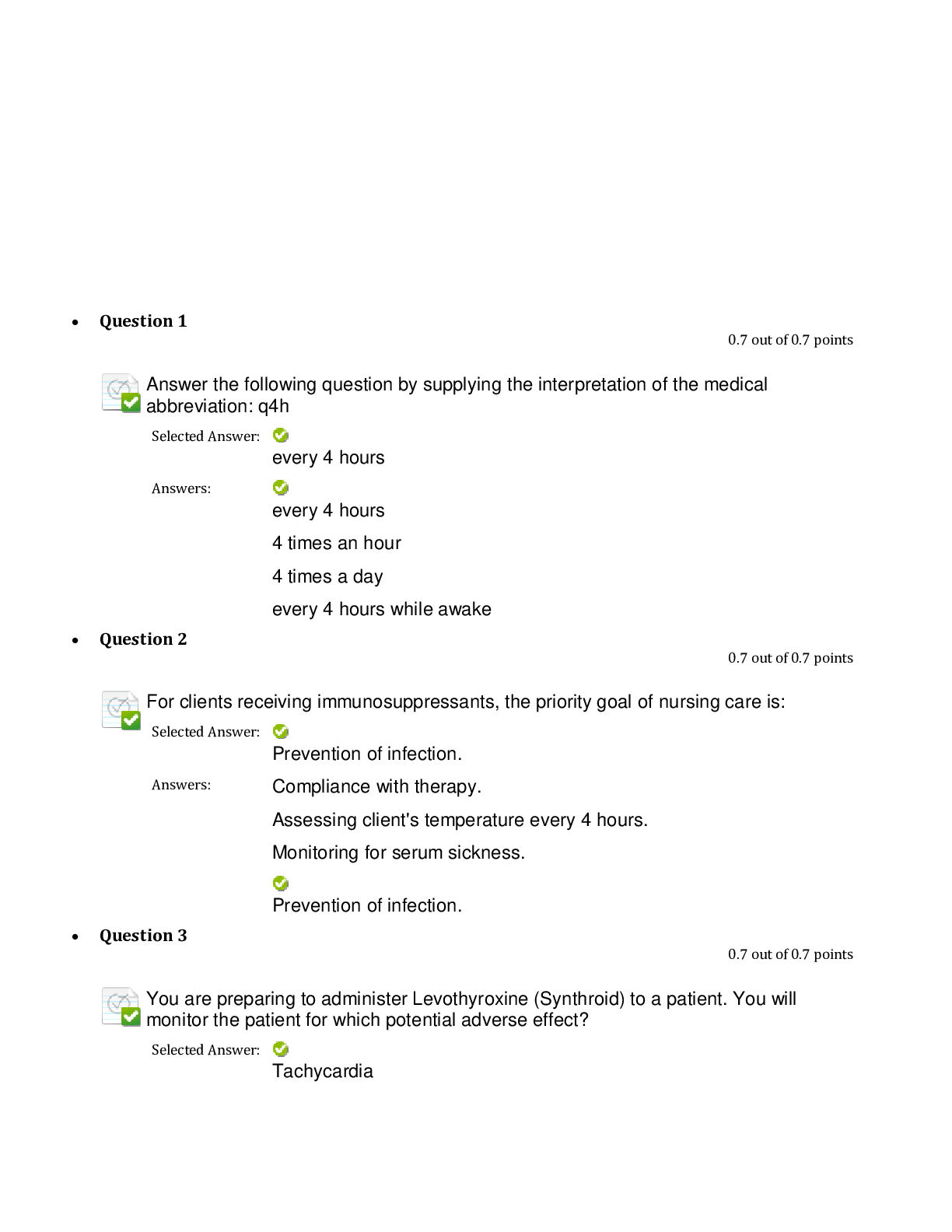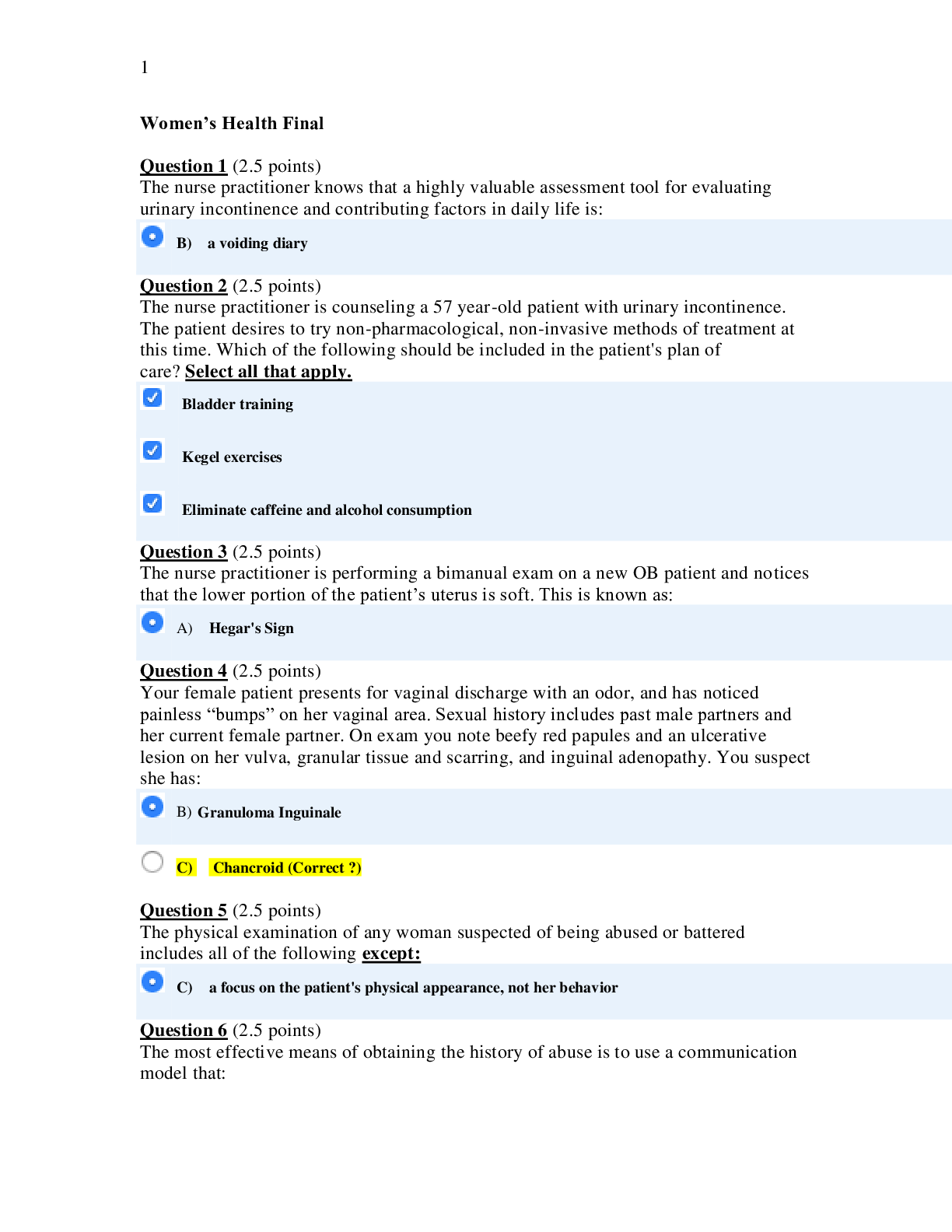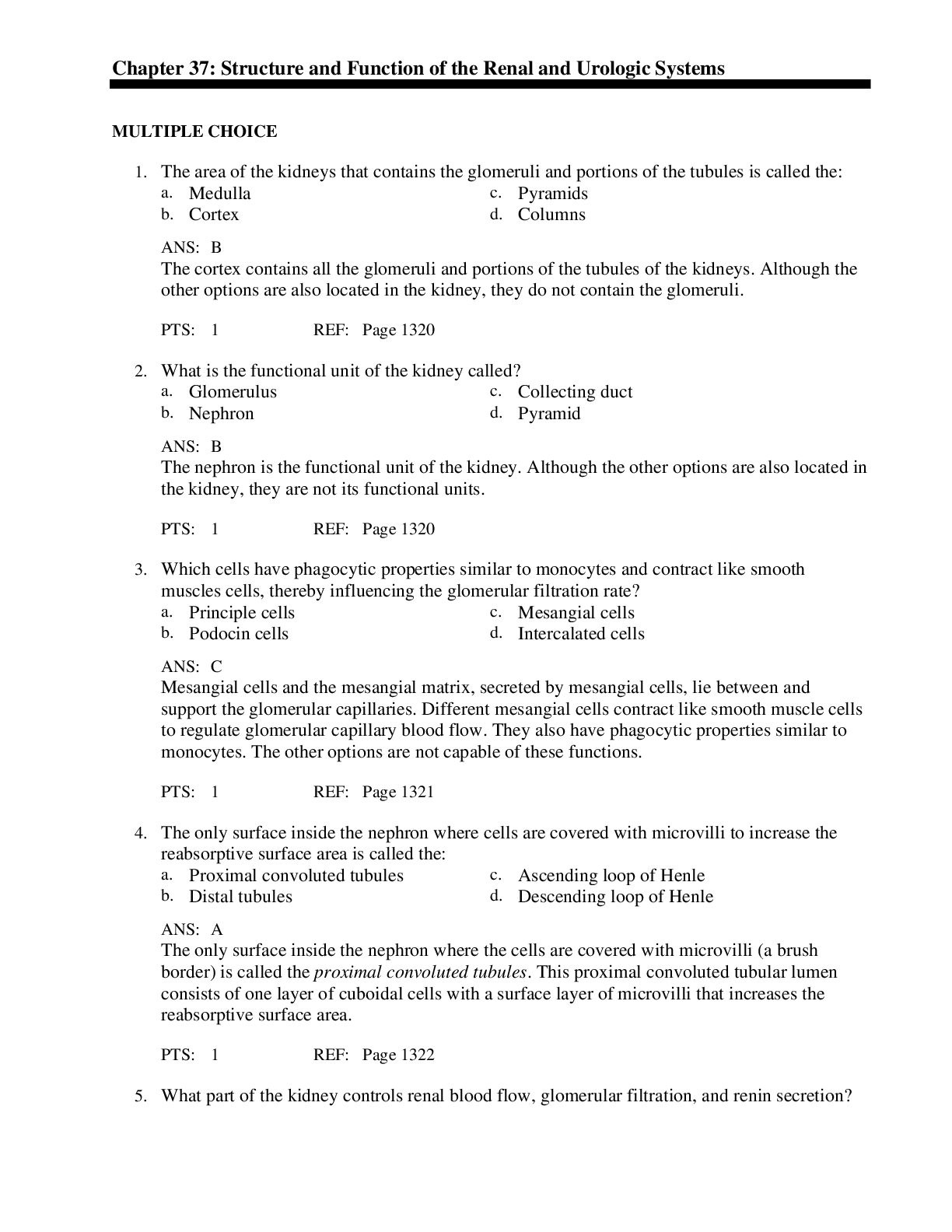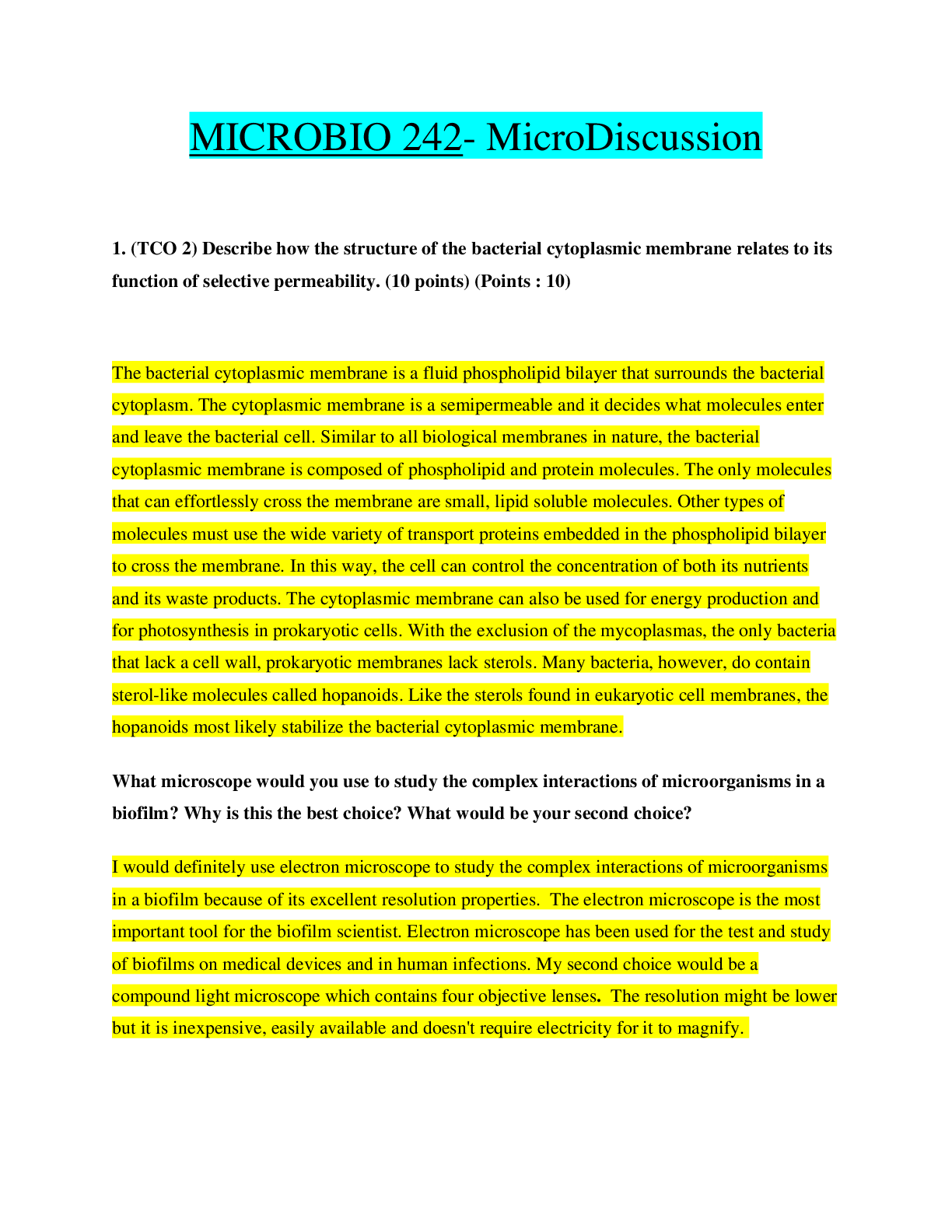*NURSING > QUESTIONS & ANSWERS > NURSING 4710 _ NUR 4710 COMPLETE FINAL EXAM (ALL CORRECT ANSWERS) (All)
NURSING 4710 _ NUR 4710 COMPLETE FINAL EXAM (ALL CORRECT ANSWERS)
Document Content and Description Below
NURSING 4710 Question 1 See full question A school-age child has a fever, joint inflammation, and a nonpruritic rash. Knowing that these are signs of rheumatic fever, the nurse should ask the par... ents: Question 2 See full question A 7-year-old boy is hospitalized with cystic fibrosis. To help him manage secretions and avoid respiratory distress, the nurse should: Question 3 See full question A disabled school-age child whose parents are overprotective may display which characteristics? Question 4 See full question The mother tells the nurse she will be afraid to allow her child with hemophilia to participate in sports because of the danger of injury and bleeding. After explaining that physical fitness is important for children with hemophilia, which activity should the nurse suggest as ideal? Question 5 See full question An 11-year-old child is sent to the school nurse reporting difficulty reading the blackboard in the classroom. The nurse assesses that the child does not have difficulty reading a laptop screen or reading books. What is the best action by the nurse? Question 1 See full question Several children in a kindergarten class have been treated for pinworm. To prevent the spread of pinworm, the school nurse meets with the parents and explains that they should: Question 2 See full question When attempting to facilitate spiritual support for a school-age child with a life-threatening disease and his family, which action would hinder the nurse-client relationship? Question 3 See full question A parent asks, "Can I get head lice too?" The nurse indicates that adults can also be infested with head lice but that pediculosis is more common among school children, primarily for what reason? Question 4 See full question Which suggestion would be most appropriate in helping parents to prepare their children for entry into school? Question 5 See full question When assessing the child with asthma for allergic rhinitis, what is an expected finding? Question 1 See full question When developing the plan of care for a school-age child with acute poststreptococcal glomerulonephritis who has a fluid restriction of 1,000 mL/day, which fluid should the nurse consider as most appropriate for the client's condition and effective for preventing excessive thirst? Question 2 See full question The mother of an 8-year-old with diabetes tells the nurse that she does not want the school to know about her daughter's condition. The nurse should reply: Question 3 See full question The nurse is caring for a child with cystic fibrosis who is admitted to the floor with an upper respiratory tract infection. The child has labored breathing and a congested, nonproductive cough. Which nursing diagnosis is the immediate priority for the nurse? Explanation: Question 4 See full question A 7-year-old has had an appendectomy on November 12. He has had pain for the last 24 hours. There is a prescription to administer acetaminophen with codeine every 3 to 4 hours as needed. The nurse is beginning the shift, and the child is requesting pain medication. The nurse reviews the chart below for pain history. Based on the information in the medical record, what should the nurse do next? Question 5 See full question Which of the following information is a priority for the nurse to teach the school-age client and parents newly diagnosed with type 1 diabetes? Question 1 See full question A nurse is caring for a 9-year-old child who has a grave prognosis after receiving a closed injury from being struck by a car. Which health team member should approach the family about organ donation? Question 2 See full question The nurse is assisting with conscious sedation for a 6-year-old undergoing a bone marrow biopsy. The nurse's most important responsibility during the procedure is to: Question 3 See full question The mother of a 10-year-old girl with diabetes asks the nurse’s advice about whether or not her child, who has always been compliant with treatment, should be allowed to go trick-or-treating on Halloween with several friends. The nurse should tell the mother: Question 4 See full question A child is admitted to the hospital with a febrile seizure. The nurse should: Question 5 See full question During a home visit, the public health nurse assesses the peritoneal catheter exit site of a child with chronic renal failure. Which finding should lead the nurse to determine a client has a risk for infection? Question 1 See full question A 10-year-old boy falls, injures his left shoulder, and is taken to the emergency department. While the client waits to be seen by the physician, what intervention should the nurse perform first? Question 2 See full question When developing a plan of care with a mother who expresses concern that her 10-year-old son is overweight, the nurse should expect to include which intervention? Question 3 See full question Which intervention should the nurse perform for a child who is receiving chemotherapy and allopurinol? Question 4 See full question Which child most needs a screening for scoliosis? Question 5 See full question A school nurse is asked to speak with a 10-year-old child who is constantly bullying other children. When talking with the child, what information would be most helpful for the nurse to obtain to help with understanding the child’s actions? Question 1 See full question A local elementary school has requested scoliosis screening for its students from the hospital's community outreach program. The school should be informed that: Question 2 See full question A 6-year-old child has tested positive for West Nile virus infection. The nurse suspects the child has the severe form of the disease when she recognizes which signs and symptoms? Question 3 See full question When planning interventions for parents who are abusive, the nurse should incorporate knowledge of which factor as a common parental indicator? Question 4 See full question A parent says that her family will soon be traveling abroad and asks why the drinking water in many regions must be boiled. The nurse should explain that, in addition to various types of dysentery, contaminated drinking water is most commonly responsible for the transmission of which disease? Question 5 See full question An 8-year-old child enters a health care facility. During assessment, the nurse discovers that the child is experiencing the anxiety of separation from his parents. The nurse makes the nursing diagnosis of Fear related to separation from familiar environment and family. Which nursing intervention is likely to help the child cope with fear and separation? Select all that apply. Question 1 See full question A third-grade child is referred to the mental health clinic by the school nurse because he is fearful, anxious, and socially isolated. After meeting with the client, the nurse talks with his mother, who says, “It is that school nurse again. She has done nothing but try to make trouble for our family since my son started school. And now you are in on it.” The nurse should respond by saying: A mother asks the nurse if the lesions around her child's mouth could be impetigo. To verify the mother's suspicions, the nurse should look for: Question 3 See full question A nurse is preparing to administer 500 mL of an IV solution to a child over 12 hours via tubing that delivers microdrips at 60 gtt/mL. At what rate should the nurse infuse the solution? Record your answer using a whole number. Question 4 See full question The nurse is caring for a child with cystic fibrosis who is admitted to the floor with an upper respiratory tract infection. The child has labored breathing and a congested, nonproductive cough. Which nursing diagnosis is the immediate priority for the nurse? Question 5 See full question A nurse is planning care for a hospitalized child who is 10 years of age, and is delegating care to a pediatric care assistant. When a nurse delegates a task to an unlicensed assistive personnel (UAP), which factor is most important? Question 1 See full question A 6-year-old child is admitted for an appendectomy. What is the most appropriate way for the nurse to prepare the child for surgery? Question 2 See full question When teaching the parents of a child with a ventricular septal defect who is scheduled for a cardiac catheterization, the nurse explains that this procedure involves the use of which technique? Question 3 See full question A 9-year-old child with Guillain-Barré syndrome requires mechanical ventilation. Which action should the nurse take? Question 4 See full question A child with leukemia has petechiae; gums, lips, and nose that bleed easily; and bruising on various parts of her body. Which laboratory test results should the nurse correlate with these findings? Question 5 See full question The nurse is assessing an 11-year-old female, using the Tanner staging of puberty. Which finding indicates preadolescent development of the breasts? Question 1 See full question A child, age 6, is brought to the health clinic for a routine checkup. To assess the child's vision, the nurse should ask: Question 2 See full question Which relaxation strategy would be effective for a school-age child to use during a painful procedure? Question 3 See full question Which statement made by the parent of a school-age child who has had a craniotomy for a brain tumor would warrant further exploration by the nurse? Question 4 See full question For a child receiving steroids in therapeutic doses over a long period, the nurse should: Question 5 See full question What instructions should the nurse give to the parents of an 8-year-old child with asthma who is being switched from parenteral steroid therapy to a daily dose of oral prednisone? Question 1 See full question A child, age 9, is admitted to the emergency department with abdominal pain. The child's mother states the pain began about 12 hours ago. The nurse notes the child has a temperature of 100.8° F (38.2° C) and nausea. The child vomited once. Which abdominal area would be most appropriate for the nurse to assess? Question 2 See full question An 8-year-old child is suspected of having meningitis. Signs of meningitis include: Question 3 See full question A 10-year-old has just spilled hot liquid on his arm, and a 4-inch (10-cm) area on his forearm is severely burned. His mother calls the emergency department. What should the nurse advise the mother to do? Question 4 See full question A child newly diagnosed with rheumatic fever is to receive penicillin therapy. Which statement by the parents should lead the nurse to judge that the parents understand the teaching about penicillin as part of the treatment plan? Question 5 See full question The nurse is caring for a child in pain, and the parents are distraught and arguing about the child’s condition. Which of the following interventions are appropriate for the nurse to take to help the parents cope? Select all that apply. Question 1 See full question When developing a teaching plan for the parent of an asthmatic child concerning measures to reduce allergic triggers, which suggestion should the nurse include? Question 2 See full question A 10-year-old child hospitalized with acute poststreptococcal glomerulonephritis during the acute stage has elevated blood pressure and low urine output for 14 hours. The nurse should next: • . Question 3 See full question A 10-year-old child is taking high doses of aspirin. Which finding indicates the child is experiencing early salicylate toxicity? Question 4 See full question A nurse is assessing a child who has a mild intellectual disability. The best indication of how this child is progressing can be obtained by observing him: Question 5 See full question A child who is of preschool age is diagnosed as having severe autism. The most effective therapy involves which intervention? Question 1 See full question When developing the discharge teaching plan for the parents of a child who has undergone a cardiac catheterization for ventricular septal defect, which information should the nurse expect to include? Question 2 See full question A child who was intubated after a craniotomy now shows signs of decreased level of consciousness. The health care provider (HCP) prescribes manual hyperventilation to keep the PaCO2 between 25 and 29 mm Hg and the PaO2 between 80 and 100 mm Hg. The nurse interprets this prescription based on the understanding that this action will accomplish which goal? Question 3 See full question An 8-year-old child has been admitted to the oncology unit with a suspected diagnosis of acute lymphoblastic leukemia. The nurse is obtaining a health history from the parents. During the interview, the parents ask the nurse if any of the factors discussed would make their child more at risk for this type of leukemia. What information about potential risk factors is correct for the nurse to share with the parents? Question 4 See full question The nurse is assisting with spirometry testing for a 6-year-old child with asthma. Which of the following instructions is most important for the nurse to give the child to obtain an accurate reading? Question 5 See full question A school nurse is teaching 4th graders about preventing injuries when riding bicycles, skateboarding, or using scooters. Which of the following is the best way for the nurse to motivate the children to use safety equipment? Question 1 See full question Parents of a 9-year-old child in the terminal phase of a fatal illness ask the nurse for guidance in discussing death with their child. Which response is appropriate? Question 2 See full question A child, age 10, is hospitalized for treatment of acute osteomyelitis. After assessing swelling and tenderness of the left tibia, the nurse initiates antibiotic therapy as ordered. The child's left leg is immobilized in a splint. What is an appropriate expected outcome for this child? Question 3 See full question A nurse practicing in a nurse-managed clinic suspects that an 8-year-old child's chronic sinusitis and upper respiratory tract infections may result from allergies. She orders an immunoglobulin assay. Which immunoglobulin would the nurse expect to find elevated? Question 4 See full question During the initial assessment of a child admitted to the pediatric unit with osteomyelitis of the left tibia, when assessing the area over the tibia, which is an expected finding? Question 5 See full question For a child receiving steroids in therapeutic doses over a long period, the nurse should: Question 1 See full question A nurse is reviewing a care plan for a 10-year-old child who has recently been diagnosed with type 1 diabetes. Which instruction should the nurse remove from a teaching plan focusing on proper hygiene? Question 2 See full question When teaching the parents of a child with a ventricular septal defect who is scheduled for a cardiac catheterization, the nurse explains that this procedure involves the use of which technique? Question 3 See full question The health care provider (HCP) has ordered intravenous mannitol for a child with a head injury. The best indicator that the drug has been effective is: Question 4 See full question A nurse evaluating a school-age child for signs and symptoms of adverse effects from morphine should assess for which of the following? Select all that apply. Question 5 See full question Which nursing intervention should be done first when managing a pediatric client admitted to the emergency department with severe diabetic ketoacidosis (DKA)? Question 1 See full question Which behavior exhibited by parents of a chronically ill child may indicate feelings of guilt about the child's illness? Question 2 See full question While the nurse is delivering abdominal thrusts to a 6-year old who is choking on a foreign body, the child begins to cry. What should the nurse do next? Question 3 See full question The nurse observes as a child with Duchenne muscular dystrophy attempts to rise from a sitting position on the floor. After attaining a kneeling position, the child "walks" his hands up his legs to stand. The nurse documents this as which sign? Question 4 See full question Which statement indicates that the parents understand the need for their child to receive long-term antibiotic therapy after an episode of rheumatic fever? Question 5 See full question The nurse is caring for a child in pain, and the parents are distraught and arguing about the child’s condition. Which of the following interventions are appropriate for the nurse to take to help the parents cope? Select all that apply. Question 1 See full question Which beverage should the nurse plan to give a child with leukemia to relieve nausea? Question 2 See full question Which sign should lead the nurse to suspect that a child with meningitis has developed disseminated intravascular coagulation? Question 3 See full question When obtaining the initial health history from a 10-year-old child with abdominal pain and suspected appendicitis, which question would be most helpful in eliciting data to help support the diagnosis? Question 4 See full question The nurse is planning care for a child with acute glomerulonephritis. The nurse should report which finding to the primary care provider? Question 5 See full question The nurse is planning interventions for a school-aged child hospitalized with acute poststreptococcal glomerulonephritis in need of diversional activity. Which activity should the nurse expect to include? [Show More]
Last updated: 1 year ago
Preview 1 out of 24 pages

Buy this document to get the full access instantly
Instant Download Access after purchase
Add to cartInstant download
We Accept:

Reviews( 0 )
$9.50
Document information
Connected school, study & course
About the document
Uploaded On
May 24, 2020
Number of pages
24
Written in
Additional information
This document has been written for:
Uploaded
May 24, 2020
Downloads
0
Views
41













